зеркало из https://github.com/microsoft/SmartDump.git
215 строки
9.9 KiB
Markdown
215 строки
9.9 KiB
Markdown
# Introduction:
|
||
|
||
SmartDump is a flexible command line utility to capture exception logs and memory dump files against a target process based on user specified settings like filter strings or memory addresses of breakpoints. This tool also focuses on addressing several scenarios that we cannot utilize some well-known and most widely used debugging tools, for example:
|
||
|
||
1. iDNA Trace(TTT/TTD) cannot be used within Kudu console or RDP for Azure Web Sites related debugging scenarios.
|
||
2. Debug Diagnostic Tool(DebugDiag) cannot be installed and used for Kudu console or RDP as well.
|
||
3. Procdump works with Kudu but may not successfully capture managed exceptions against web hosts with .Net Core runtime.
|
||
4. For intermittent issues, capturing iDNA Trace(TTT/TTD) may not be an appropriate approach even with selective recording.
|
||
|
||
Currently SmartDump is still under development. New features are continuously being added.
|
||
Bug reports, suggestions and feedback from you will be very much appreciated.
|
||
|
||
|
||
# How to Use:
|
||
|
||
Below is a detailed step-to-step demo.
|
||
|
||
1. First of all, we need to open Kudu console and drag/upload the tool into the site folder.
|
||
|
||

|
||
|
||
|
||
|
||
2. Next, we need to find the PID of our site’s w3wp.exe from Process Explorer.
|
||
|
||
NOTE: the one with (scm) is for Kudu console. Hence we always have to focus on w3wp.exe without (scm).
|
||
|
||

|
||
|
||
|
||
|
||
3. Then we can run SmartDump.exe and use -p option to specify the PID found in step #2.
|
||
|
||
This makes SmartDump attach to the target process and start to monitor any exception thrown in it. By default, the tool captures 5 exceptions.
|
||
|
||

|
||
|
||
After submitting requests to generate some exceptions, SmartDump will be able to capture them within the console.
|
||
|
||
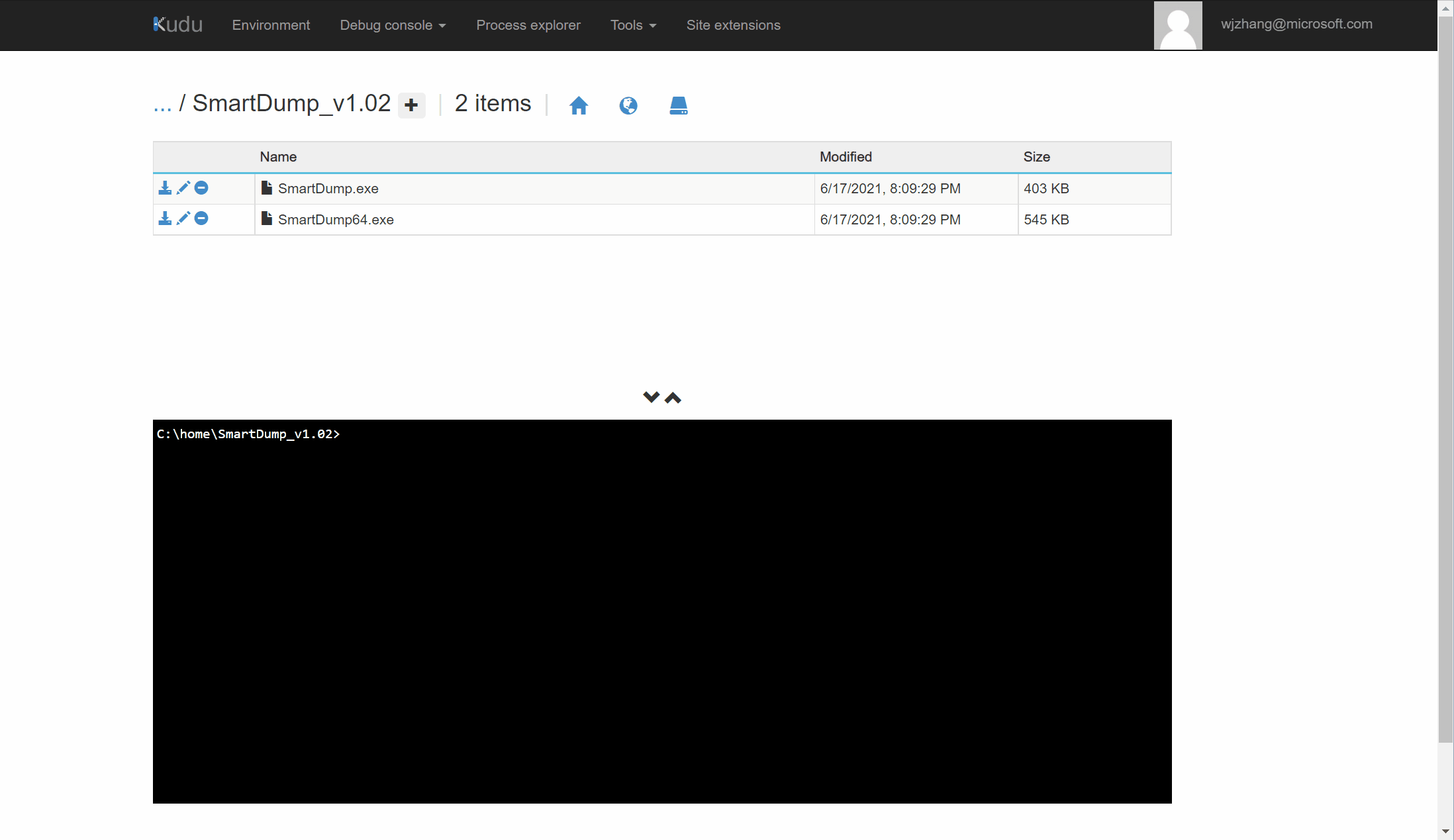
|
||
|
||
|
||
|
||
4. If you want to see more exceptions, just use -n option to specify number of exceptions to be captured.
|
||
|
||
NOTE: using -n 0 to start an unlimited/endless capture. However please be careful to use this in Kudu because it doesn’t support Ctrl+C to exit a process. Run inside a common cmd.exe without such issue.
|
||
|
||
Tips: you can also add: > filename.log at the end of a command to make Kudu write output into a log file for you.
|
||
|
||

|
||
|
||
|
||
|
||
5. To generate dump, use -d option to set number of dumps to be captured. Associating it with -f(filter include) allows you to capture dumps against specific exceptions. Also, use -fv (filter exclude) options to filter/exclude any unnecessary exceptions from output.
|
||
|
||
- -f Filter exception based on specified string(s). Use '|' as delimiter for multiple strings.
|
||
- -fv Exclude exceptions contain specified filter. Use '|' as delimiter for multiple strings.
|
||
|
||

|
||
|
||
|
||
|
||
6. The tool also supports to set memory address of breakpoint to generate dump files.
|
||
|
||
You can capture a dump first and then open it in debugger to find the code entry address of a function you interest in(or code address of any line).
|
||
Then use -a option of SmartDump to set the address as breakpoint for capture:
|
||
|
||

|
||

|
||
|
||
|
||
|
||
|
||
# Usage:
|
||
|
||
SmartDump x86/x64 - exception and memory dump capture utility
|
||
|
||
**Options:**
|
||
|
||
-p PID of target process.
|
||
|
||
-n Number of exceptions to be captured. Default is 5. Set to 0 means unlimited.
|
||
|
||
-d Collect number of dumps.
|
||
|
||
-de Collect number of dumps in 'Dump for each' mode. Dumps will be captured for each of different exception types.
|
||
|
||
-f Filter(include) exception based on specified string(s). Use '|' as delimiter for multiple strings.
|
||
|
||
-fv Exclude exceptions contain specified filter. Use '|' as delimiter for multiple strings.
|
||
|
||
-s Skip the first number of exceptions for dump capture.
|
||
|
||
-ma Capture a manual dump.
|
||
|
||
-mn Option to captue a mini dump. Default setting is to capture full memory dumps.
|
||
|
||
-a Address of breakpoint.
|
||
|
||
-o Output path of dump(s).
|
||
|
||
-h Or -?/-help. Display usage and examples.
|
||
|
||
|
||
Examples:
|
||
------------------------------------------
|
||
|
||
- Write a manual dump against process with id 4567:
|
||
SmartDump.exe -ma -p 4567
|
||
|
||
- Monitor and print 10 managed exceptions against process with id 4567:
|
||
SmartDump.exe -p 4567 -n 10
|
||
|
||
- Capture two dumps based on filtered strings of managed exceptions:
|
||
SmartDump.exe -p 4567 -f "Object reference not set|ArgumentException" -n 10 -d 2
|
||
|
||
- Exclude exceptions contain specified filter string from output:
|
||
SmartDump.exe -p 4567 -n 10 -fv "InvalidOperationException|FileNotFoundException"
|
||
|
||
- Skip the first 3 NullReferenceException. Capture a memory dump for the 4th one and specify output path to: c:\home\dump.
|
||
SmartDump.exe -p 4567 -n 10 -f "NullReferenceException" -s 3 -d 1 -o c:\home\dump
|
||
|
||
- Capture 3 mini dumps for each of the exception types: NullReferenceException, SocketException and ArgumentException
|
||
SmartDump.exe -p 4567 -n 10 -de 3 -mn -f "NullReferenceException|SocketException|ArgumentException"
|
||
|
||
- Capture a dump based on specified address of breakpoint:
|
||
SmartDump.exe -d 1 -p 4567 -a 7a64e9d0 -n 1
|
||
|
||
The following are several sample commands that uses the tool with Kudu debug console.
|
||
|
||
1) Show options and examples
|
||
|
||
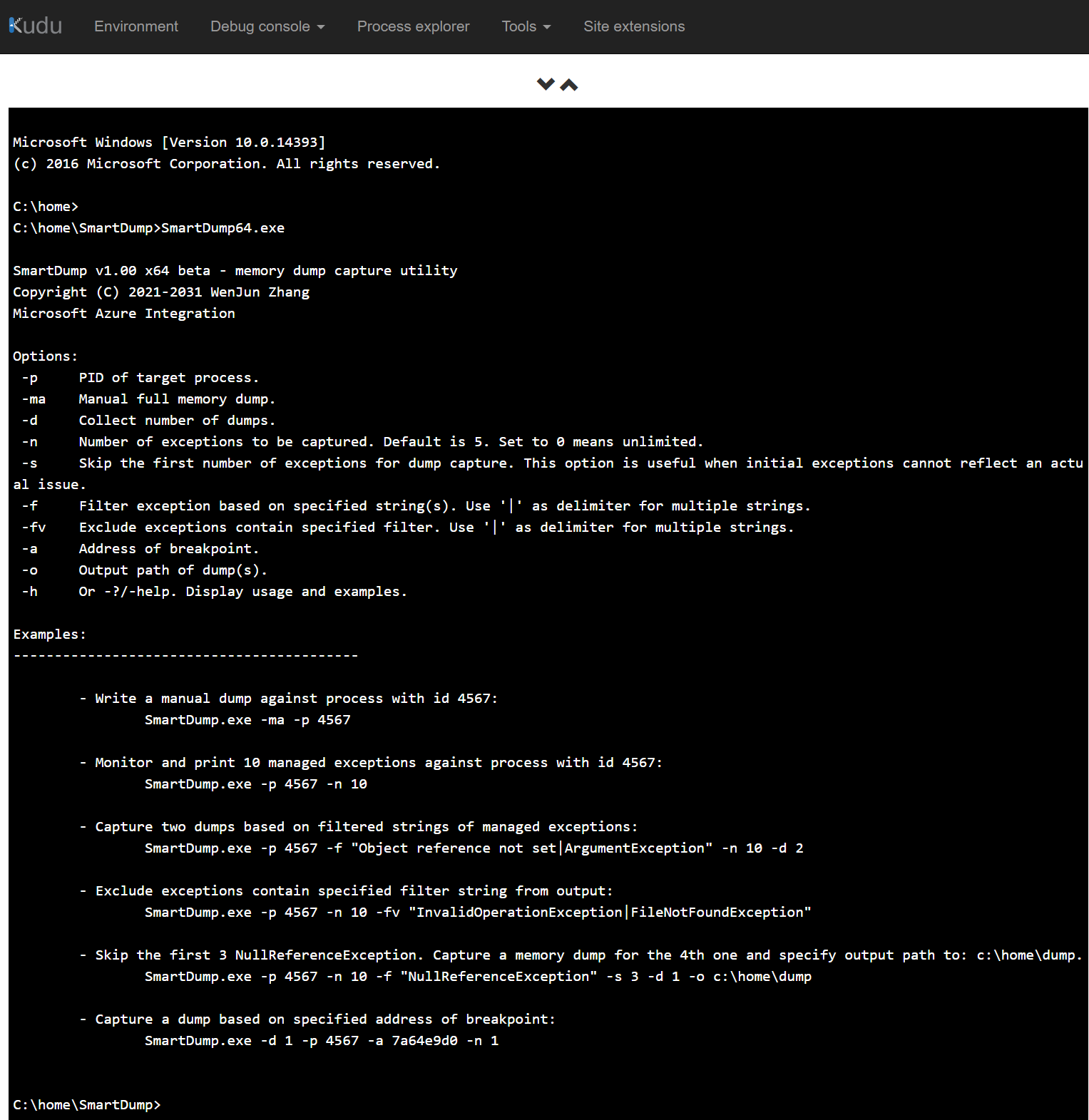
|
||
|
||
|
||
2) Monitor and display exceptions
|
||
|
||

|
||
|
||
|
||
3) Capture a manual dump
|
||
|
||

|
||
|
||
|
||
4) Capture two exception dumps based on filter string.
|
||
|
||
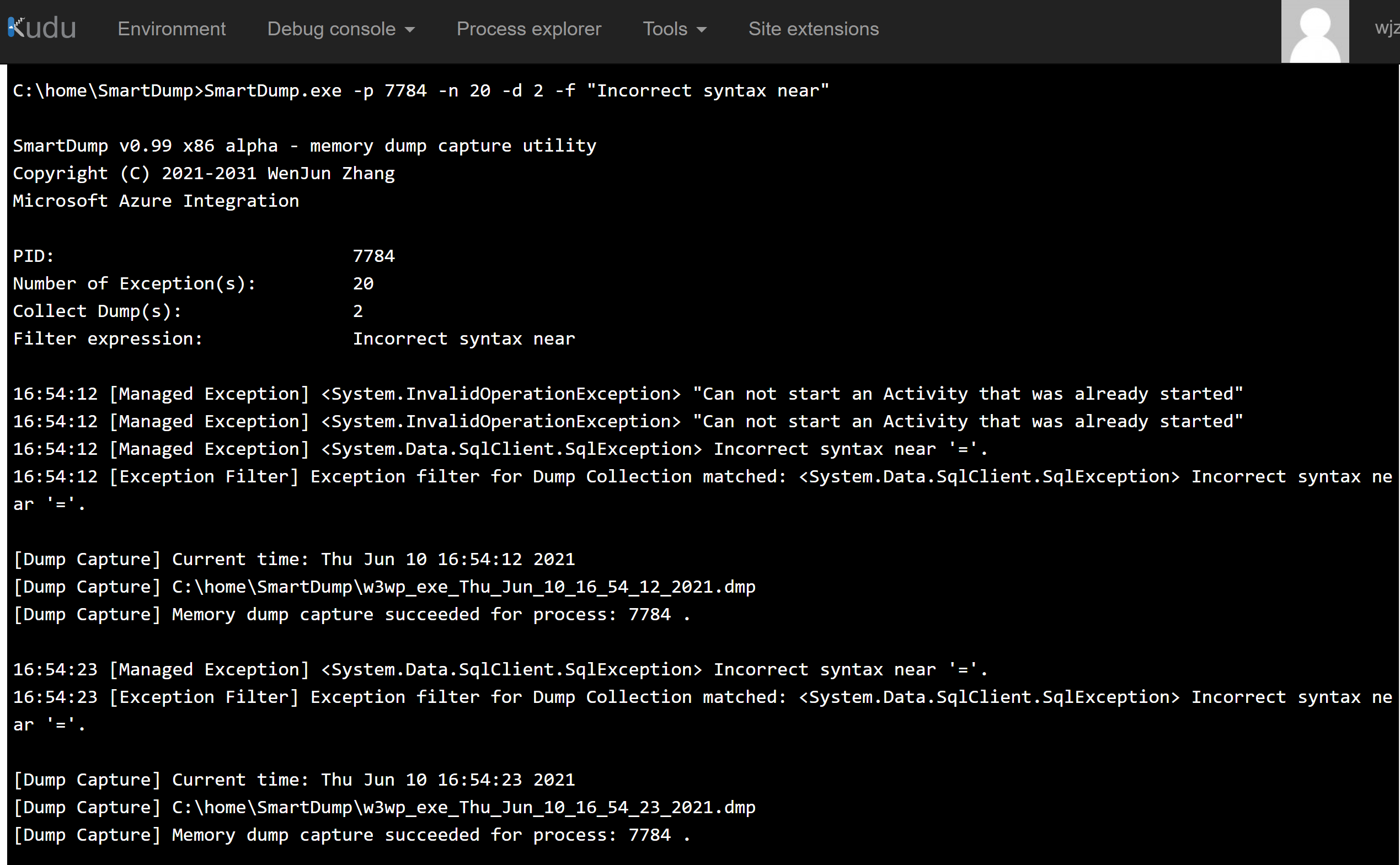
|
||
|
||
|
||
5) Exclude/filter uninterested exceptions based on specified strings delimited with '|'
|
||
|
||
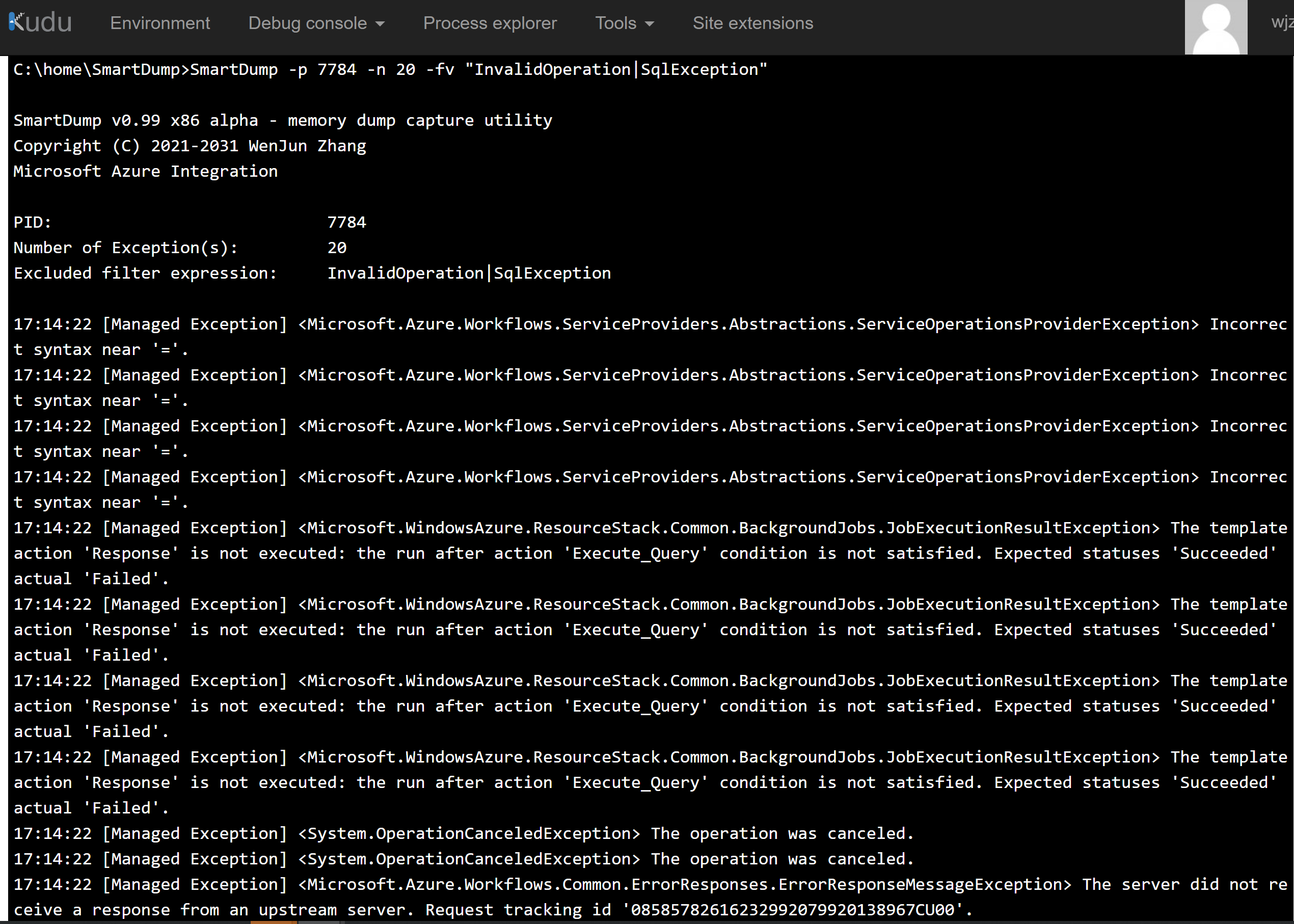
|
||
|
||
|
||
6) Collect dump based on specified address of breakpoint.
|
||
|
||

|
||
|
||
|
||
7) Skip the first 3 SqlException. Capture two memory dumps for the 4th and 5th ones and specify output path to: c:\home\dump.
|
||
|
||

|
||
|
||
|
||
8) Use -de 'Dump for each' option to capture 3 mini dump files for 3 specified exception types: InvalidOperationException, SqlException and ServiceOperationsProviderException.
|
||
|
||
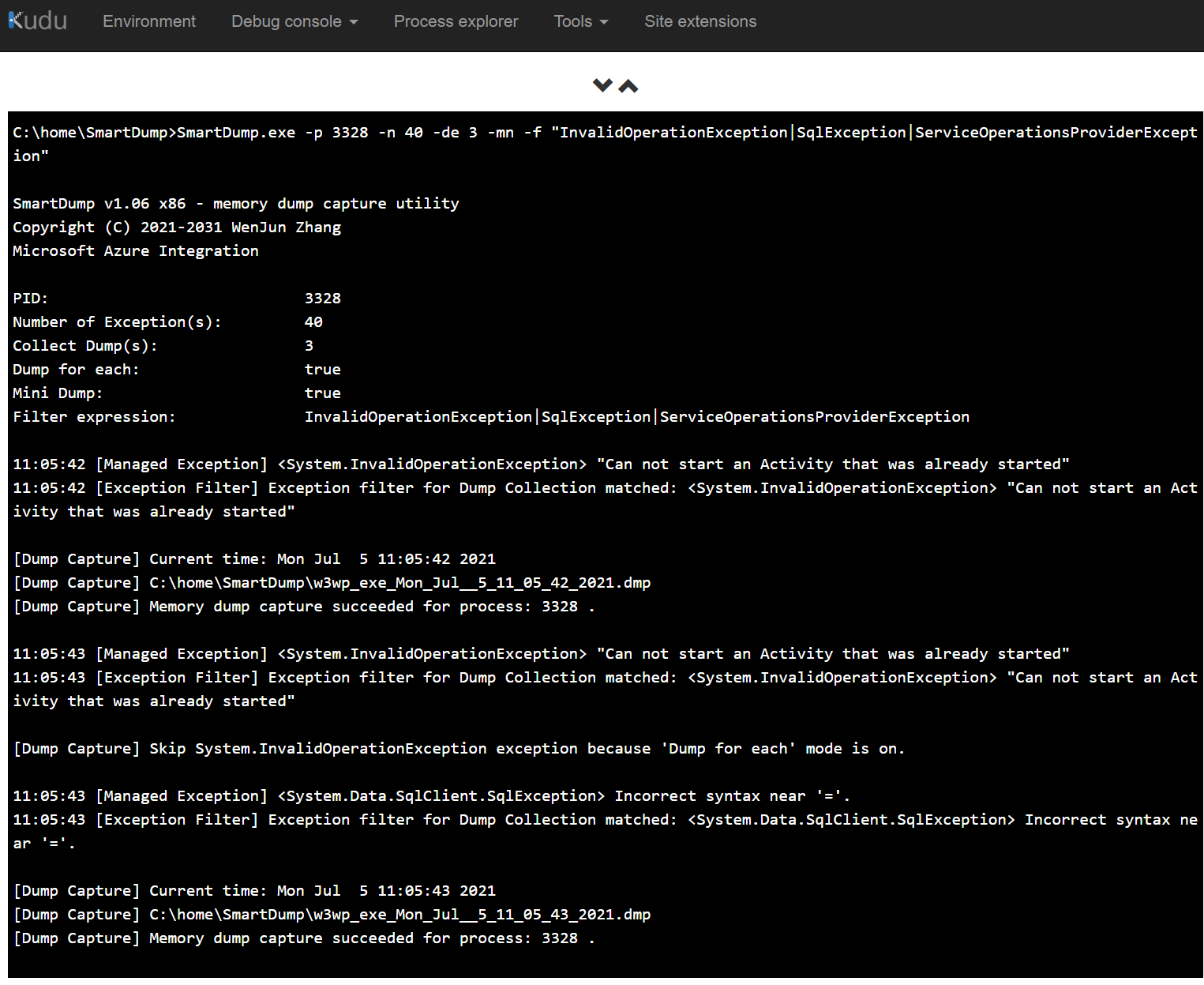
|
||
|
||
|
||
9) Use SmartDump to write a log of exceptions for your site.
|
||
|
||

|
||

|
||
|
||
|
||
10) Capture against process of onpromise environment
|
||
|
||

|
||
|
||
|
||
# Project
|
||
|
||
> This repo has been populated by an initial template to help get you started. Please
|
||
> make sure to update the content to build a great experience for community-building.
|
||
|
||
As the maintainer of this project, please make a few updates:
|
||
|
||
- Improving this README.MD file to provide a great experience
|
||
- Updating SUPPORT.MD with content about this project's support experience
|
||
- Understanding the security reporting process in SECURITY.MD
|
||
- Remove this section from the README
|
||
|
||
## Contributing
|
||
|
||
This project welcomes contributions and suggestions. Most contributions require you to agree to a
|
||
Contributor License Agreement (CLA) declaring that you have the right to, and actually do, grant us
|
||
the rights to use your contribution. For details, visit https://cla.opensource.microsoft.com.
|
||
|
||
When you submit a pull request, a CLA bot will automatically determine whether you need to provide
|
||
a CLA and decorate the PR appropriately (e.g., status check, comment). Simply follow the instructions
|
||
provided by the bot. You will only need to do this once across all repos using our CLA.
|
||
|
||
This project has adopted the [Microsoft Open Source Code of Conduct](https://opensource.microsoft.com/codeofconduct/).
|
||
For more information see the [Code of Conduct FAQ](https://opensource.microsoft.com/codeofconduct/faq/) or
|
||
contact [opencode@microsoft.com](mailto:opencode@microsoft.com) with any additional questions or comments.
|
||
|
||
## Trademarks
|
||
|
||
This project may contain trademarks or logos for projects, products, or services. Authorized use of Microsoft
|
||
trademarks or logos is subject to and must follow
|
||
[Microsoft's Trademark & Brand Guidelines](https://www.microsoft.com/en-us/legal/intellectualproperty/trademarks/usage/general).
|
||
Use of Microsoft trademarks or logos in modified versions of this project must not cause confusion or imply Microsoft sponsorship.
|
||
Any use of third-party trademarks or logos are subject to those third-party's policies.
|